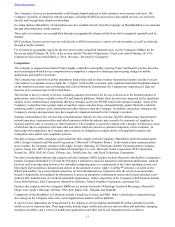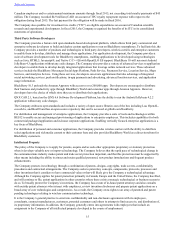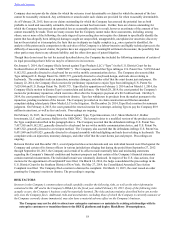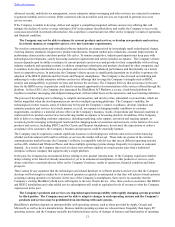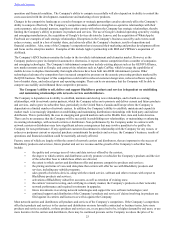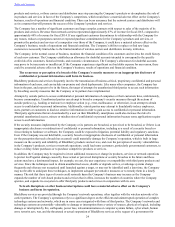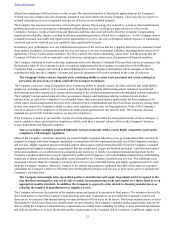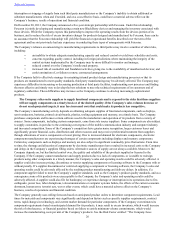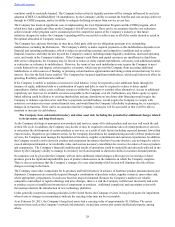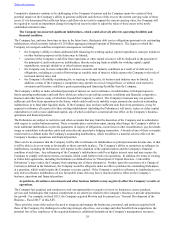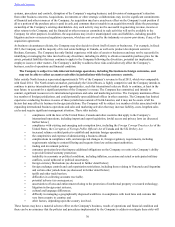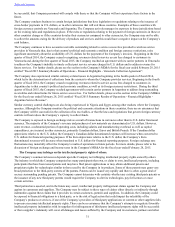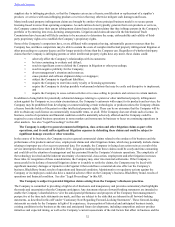Blackberry 2015 Annual Report Download - page 32
Download and view the complete annual report
Please find page 32 of the 2015 Blackberry annual report below. You can navigate through the pages in the report by either clicking on the pages listed below, or by using the keyword search tool below to find specific information within the annual report.
Table of Contents
23
operation and financial condition. The Company's ability to compete successfully will also depend on its ability to control the
costs associated with the development, manufacture and marketing of new products.
Changes in the competitive landscape as a result of mergers or strategic partnerships can also adversely affect the Company’s
ability to compete effectively. The Company’s competitors may establish or strengthen co-operative relationships with their
carrier partners, sales channel partners, suppliers or other parties with whom the Company has strategic relationships, thereby
limiting the Company’s ability to promote its products and services. The use of Google’s Android operating system by existing
and emerging manufacturers, the acquisition of Google’s devices division by Lenovo, and the acquisition of WhatsApp by
Facebook are examples of such strategic relationships. Disruptions in the Company’s business caused by such events could
reduce revenue, result in a loss of market share, and adversely affect the Company’s business, results of operations and
financial condition. Also, some of the Company’s competitors have increased their marketing and product development efforts
and focus on the enterprise market. Examples of this include Apple’s partnership with IBM and VMWare’s acquisition of
AirWatch.
The Company’s QNX business remains the leader in the in-vehicle infotainment and telematics market. However, as the
Company pushes to grow its footprint in automotive electronics, it expects intense competition from a number of companies
and emerging technologies. The Company’s infotainment competitors include existing players such as the GENIVI Alliance,
new market entrants such as Google, and connectivity solutions such as Apple CarPlay, which leverage the capabilities of
mobile devices to displace functionality that might otherwise have been built into OEM infotainment systems. Other
technological advances by competitors have increased competitive pressure on the acoustic processing products marketed by
the QNX business. The impact of this competition could result in reduced customer design wins, reduced software royalties,
loss of market share, and reduced gross and operating margins. There can be no assurance that the Company will be able to
compete successfully and withstand these competitive pressures.
The Company’s ability to sell, deliver and support BlackBerry products and services is dependent on establishing
and maintaining relationships with network carriers and distributors.
The Company is dependent on its ability to establish, maintain and develop new relationships, and to build on existing
relationships, with its network carrier partners, which the Company relies on to promote and deliver current and future products
and services, and to grow its subscriber base, particularly in the United States, Canada and Europe where the Company is
dependent on a limited number of network carriers. In addition, the Company’s ability to establish, maintain and expand its
market reach is increasingly dependent on establishing and maintaining distribution relationships with third party and indirect
distributors. This is particularly the case in emerging and growth markets such as the Middle East, Asia and Latin America.
There can be no assurance that the Company will be successful in establishing new relationships, or maintaining or enhancing
its existing relationships, with network carriers or distributors. Non-performance by the Company under its contracts with
network carriers or distributors may have significant adverse consequences that may involve penalties to be paid by the
Company for non-performance. If any significant customer discontinues its relationship with the Company for any reason, or
reduces or postpones current or expected purchase commitments for products and services, the Company’s business, results of
operations and financial condition could be materially adversely affected.
Factors, some of which are largely within the control of network carriers and distributors, that are important to the success of
BlackBerry products and services, future product and service revenue and the growth of the Company’s subscriber base,
include:
• the quality and coverage area of voice and data services offered by the carriers;
• the degree to which carriers and distributors actively promote or subsidize the Company’s products and the size
of the subscriber base to which these efforts are directed;
• the extent to which carriers and distributors offer and promote competitive products and services;
• the pricing and terms of voice and data plans that carriers will offer for use with BlackBerry products and
services, including any subsidy programs;
• sales growth of wireless devices, along with the related service, software and other revenues with respect to
BlackBerry products and services;
• activations of BlackBerry subscriber accounts, as well as retention of existing ones;
• the carriers’ interest in testing, and certifying in a timely manner, the Company’s products on their networks;
• network performance and required investments in upgrades;
• future investments in evolving network technologies and support for new software technologies; and
• continued support and distribution of the Company’s products and services if claims involving its products are
filed against its carriers and licensees as well as against the Company.
Most network carriers and distributors sell products and services of the Company’s competitors. If the Company’s competitors
offer their products and services to the carriers and distributors on more favorable contractual or business terms, have more
products and services available, or those products and services are, or are perceived to be, in higher demand by end users, or are
more lucrative for the carriers and distributors, there may be continued pressure on the Company to reduce the price of its


